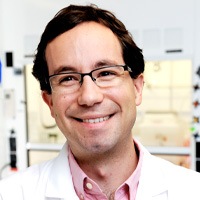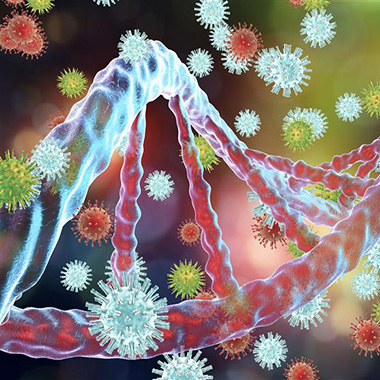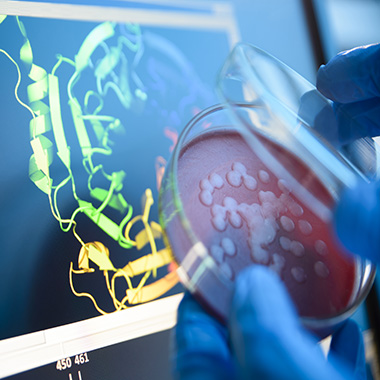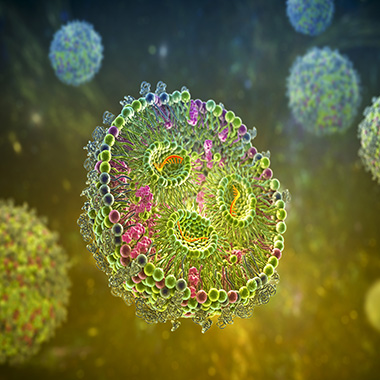Chemistry and Cancer
30 members representing nine departments at UT Southwestern
The interdisciplinary Chemistry and Cancer (CC) Program plays a pivotal role in translating basic science research into groundbreaking cancer therapies. By seamlessly integrating fundamental research with drug discovery, early cancer imaging technologies, and biomedical engineering solutions to cancer problems, the CC Program has facilitated numerous collaborations, resulting in significant advances in cancer biology, clinically relevant drug discoveries, cancer detection agents, and drug delivery systems. Combining the expertise of synthetic and medicinal chemists, molecular and structural biologists, biomedical engineers, biochemists, chemical biologists, pharmacologists, and clinician scientists, members of the CC Program are dedicated to discovering, designing, and optimizing small molecules and other therapeutic approaches that target deregulated biological pathways in cancer.
The CC Program aids the journey of small molecule discoveries into pre-clinical and clinical studies. Efforts also include chemical synthesis and development of tumor imaging and theranostic probes, chemical synthesis and engineering of drug delivery systems, and related engineering strategies for creation and clinical translation of novel cancer therapies. The program operates on the premise that interdisciplinary chemistry- and engineering-focused approaches to cancer biology can unlock new avenues for cancer prevention and treatment.
The central themes of the CC Program are guided by three specific aims: (1) Identification of Molecular Targets of Novel Anti-Cancer Agents, (2) Structure-Based Drug Design of Chemicals that Perturb Cancer-Relevant Signaling Pathways, and (3) Development of Biomedical Engineering Approaches for Cancer Detection, Imaging, and Treatment.
Identification of Molecular Targets of Novel Anti-Cancer Agents
Forward Genetics to Discover Novel Drugs and Therapeutic Targets
Deepak Nijhawan, M.D., Ph.D., Bruce Posner, Ph.D., Joseph Ready, Ph.D., and Jeff De Brabander, Ph.D., developed an inducible mutagenesis system that enhances forward genetic screening in cancer cells by modulating DNA mismatch repair. This method improves detection of resistance mutations, enabling target identification for cytotoxic compounds, including destruxins and NAMPT inhibitors. It streamlines mechanism-of-action studies and supports precision oncology drug development.Structure-Based Drug Design of Chemicals that Perturb Cancer-Relevant Signaling Pathways
Selective Inhibition of JNK2 for the Treatment of Cancer
Kenneth Westover, M.D., Ph.D., developed YL5084, the first covalent JNK2-selective inhibitor, achieving 20-fold selectivity over JNK1. JNK2 promotes cell survival, while JNK1 induces apoptosis; therefore, isoform-selective targeting has significant therapeutic implications. Through covalent engagement of JNK2 at Cys116 and strategic structure-guided modifications, YL5084 achieved 20-fold selectivity over JNK1 with reduced off-target activity. YL5084 represents a novel chemical probe to dissect JNK2-specific signaling, particularly in multiple myeloma and other malignancies where JNK2 supports tumor growth. This study advances the selective inhibition of closely related kinases, a major challenge in drug development, and provides a new avenue for targeting essential pathways in cancer.
Development of Biomedical Engineering Approaches for Cancer Detection, Imaging, and Treatment
Lipid Nanoparticle (LNP) Discovery and Cancer Gene Therapies
Daniel Siegwart, Ph.D., and a team introduced a groundbreaking lipid nanoparticle (LNP) platform, called SORT LNPs, to generate CAR T cells directly within the body. These spleen-targeted LNPs delivered mRNA encoding anti-CD19 CARs to T cells in mice with B cell lymphoma, resulting in CAR T cell generation, increased tumor-infiltrating lymphocytes, reduced liver metastasis, and significantly extended survival. This novel method has transformative potential for cancer immunotherapy, especially for lymphomas, by simplifying CAR T production and enhancing accessibility. The research exemplifies the translation of nanomedicine and genetic drug engineering into promising preclinical cancer treatment strategies.
Notable Publications
Siegwart, D.J. et al. Bone-marrow-homing lipid nanoparticles for genome editing in diseased and malignant haematopoietic stem cells. Nature Nanotechnology 2024; 10.1038/s41565-024-01680-8. PMCID: PMC11757007.
Wang, A.Z. et al. An injectable subcutaneous colon-specific immune niche for the treatment of ulcerative colitis. Nature Biomedical Engineering 2024; 10.1038/s41551-023-01136-9. PMID: 38049469.
Gruber, J.J. et al. Genome-wide Cas9-mediated screening of essential non-coding regulatory elements via libraries of paired single-guide RNAs. Nature Biomedical Engineering 2024; 10.1038/s41551-024-01204-8. PMCID: PMC11310080.
Liszczak, G. et al. Asymmetric nucleosome PARylation at DNA breaks mediates directional nucleosome sliding by ALC1. Nature Communications 2024; 10.1038/s41467-024-45237-8. PMCID: PMC10837151.
Westover, K. et al. SRC kinase drives multidrug resistance induced by KRAS-G12C inhibition. Science Advances 2024; 10.1126/sciadv.adq4274. PMCID: PMC11633746.
De Brabrander, J.K. et al. Discovery and Optimization of N-Arylated Tetracyclic Dicarboximides That Target Primary Glioma Stem-like Cells. Journal of Medical Chemistry 2024; 10.1021/acs.jmedchem.4c00402. PMID: 38804887.
Leadership and Contact






